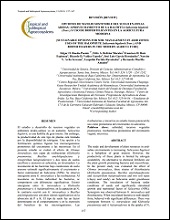OPCIONES DE MANEJO SOSTENIBLE DEL SUELO EN ZONAS ARIDAS: APROVECHAMIENTO DE LA HALÓFITA Salicornia bigelovii (Torr.) Y USO DE BIOFERTILIZANTES EN LA AGRICULTURA MODERNA
SUSTAINABLE OPTIONS FOR SOIL MANAGEMENT IN ARID ZONES: USES OF THE HALOPHYTE Salicornia bigelovii (Torr.) AND BIOFERTILIZERS IN THE MODERN AGRICULTURE
Autor
EDGAR OMAR RUEDA PUENTE
FELIX ALFREDO BELTRAN MORALES
FRANCISCO HIGINIO RUIZ ESPINOZA
RICARDO DAVID VALDEZ CEPEDA
JOSE LUIS GARCIA HERNANDEZ
NARCISO YSAC AVILA SERRANO
LEOPOLDO PARTIDA RUVALCABA
BERNARDO MURILLO AMADOR
Metadatos
Mostrar el registro completo del ítemResumen
"El estudio y desarrollo de recursos vegetales en ambientes áridos-salinos va en aumento. Salicornia bigelovii, es una halófita de gran interés. Sin embargo, la productividad de este tipo de plantas está limitada por la disponibilidad de nitrógeno. Una opción a la fertilización química figuran los microorganismos promotores del crecimiento y las micorrizas. En el presente estudio se evaluó el efecto de Glomus intraradices, tres cepas de rizobacterias (Klebsiella pneumoniae, Bacillus amyloliquefaciens y Azospirillum halopraeferens) y dos tipos de suelos (arcilloso y arenoso) en salicornia, en invernadero. La inoculación de las bacterias bajo condiciones de suelo arenoso estimuló significativamente el crecimiento y factor nutrimental de Salicornia (NPK). Se observó sinergismo entre G. intraradices y las rizobacterias. Al inocularse en forma individual las bacterias, se comportaron con diferencias significativas. Existió sinergismo entre G. intraradices y Klebsiella pneumoniae y A. halopraeferens, en la captación de N; lo contrario ocurrió con G. intraradices y Bacillus amyloliquefaciens con altos valores significativos en la absorción de P y K. El tipo de suelo fue un factor determinante en el comportamiento y en la expresión del beneficio de los microorganismos. Las rizobacterias y micorriza en estudio tienen potencial de uso como promotoras del crecimiento en salicornia. " "The study and development of plant resources in arid-saline environments is increasing. Salicornia bigelovii is a halophyte of great interest. However, the productivity of these plants is limited by nitrogen availability. An alternative to chemical fertilizers are the plant growth promoting bacteria and mycorrhizae. In the present study was evaluated the effect of Glomus intraradices, three strains of rhizobacteria (Klebsiella pneumoniae, Bacillus amyloliquefaciens and Azospirillum halopraeferens) and two soil types (clayey and sandy) on Salicornia under greenhouse conditions. The inoculation of bacteria under conditions of sandy soil significantly stimulated growth and nutritional factor of Salicornia (NPK). Synergism was observed between G. intraradices and rhizobacteria. When inoculated bacteria in individually form, behaved with significant differences. There was synergism between G. intraradices and Klebsiella pneumoniae and A. halopraeferens in the uptake of N, the opposite happened with G. intraradices and Bacillus amyloliquefaciens with high significant values in the absorption of P and K. The soil was a determining factor in behavior and expression of the benefit of the microorganisms. Rhizobacteria and mycorrhiza in the study have potential for use as growth promoters in salicornia."
Colecciones
Ítems relacionados
Mostrando ítems relacionados por Título, autor o materia.
-
PROMOCIÓN DEL PERIFITON PARA EL CULTIVO DE CAMARÓN BLANCO: HACIA UNA ACUICULTURA ECOLÓGICA
DOMENICO VOLTOLINA LOBINA; JUAN MANUEL AUDELO NARANJO; MARIA DEL ROSARIO PACHECO MARGES -
Suelo y Erosión
YOLANDA LOURDES MAYA DELGADO


